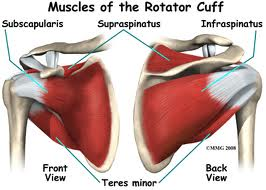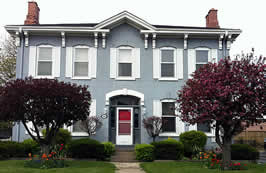 The rotator cuff is a complex of four different muscles which act in conjunction to both stabilize the gleno-humeral (shoulder) joint, and to create rotation of the shoulder (of course!). The four muscles of the rotator cuff are as follows;
The rotator cuff is a complex of four different muscles which act in conjunction to both stabilize the gleno-humeral (shoulder) joint, and to create rotation of the shoulder (of course!). The four muscles of the rotator cuff are as follows;
Supraspinatus
Infraspinatus
Teres Major
Subscapularis
Three of the four rotator cuff muscles are named for where they lie in relation to the “spine of the scapula” (shoulder blade). The spine of the scapula is the most prominent bone that you feel when you feel your shoulder blade.
Supraspinatus lies in the supraspinous fossa (fossa = groove or surface). Infraspinatus lies in the infraspinous fossa and the subscapularis lies in the subscapular fossa. The teres major lies along the lateral (outside) border of the scapula, and is closely associated with the latissmus dorsi, otherwise known as the lats.
Alright, well now that the anatomy lesson is concluded we can continue.
Why is the rotator cuff important? Due to the fact that the rotator cuff musculature acts as stabilizers for the shoulder joint, they will be affected in nearly every type of shoulder injury. The reason why the rotator cuff is so affected is that the only attachment of the shoulder girdle to the skeleton is the sterno-clavicular joint (where the collarbone meets the breastbone). Thus the musculature of the shoulder girdle plays a significant role in stabilizing the joint as a whole and is more susceptible to injury than other joints.
Ever felt a sharp pain over the top of your shoulder, that seems to drift over the outside part of your arm and perhaps even down to your hand? This could be a symptom of rotator cuff injury.
So how does a Chiropractor treat rotator cuff injuries?
The first step is to address the musculature itself through soft tissue therapies. One such therapy is ultrasound, which stimulates and facilitates regeneration of the muscle tissue in a safe and gentle manner. Also, depending on the severity and nature of the damage, more advanced soft tissue techniques involving stretching/trigger point therapy (explained in a later post) may be employed to enable more efficient healing of the tissues.
Next, the Chiropractors at Queen Street Chiropractic Centre will assess the joint complexes which surround and compose the shoulder. The acromioclavicular joint (where the collarbone meets the shoulder blade), the gleno-humeral joint (where the upper arm meets the shoulder blade), as well as the elbow and spine all will be assessed for pain and reduced range of motion.
Treatment of rotator cuff injuries is vital to reducing pain and re-establishing a full range of motion in order to avoid problems such as “frozen shoulder” (more on this later).
If you do sustain a shoulder injury, and want to return to optimal health and functionality, feel free to book an appointment to see one of the doctors at Queen Street Chiropractic Centre today.
 Did you like this article? Please consider
Did you like this article? Please consider  96 Queen Street
96 Queen Street
Leave a Reply